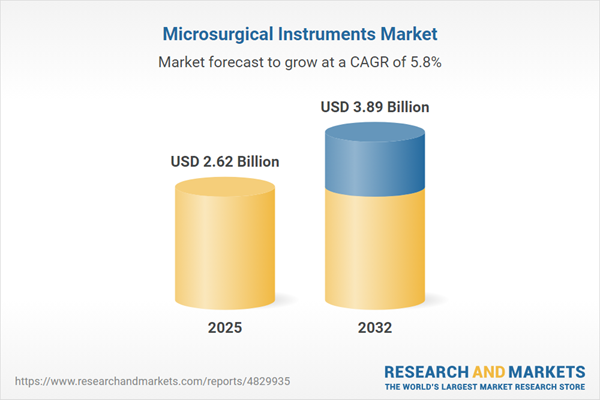Speak directly to the analyst to clarify any post sales queries you may have.
Precision microsurgical instruments are essential for healthcare providers seeking to enhance clinical outcomes and streamline surgical workflows. As market dynamics shift, senior leaders need targeted, research-backed intelligence to support resilient and innovative strategies in a competitive global landscape.
Market Snapshot: Precision Microsurgical Instruments Market Size and Growth
In 2024, the global microsurgical instruments market reached USD 2.47 billion, with projections to achieve USD 2.62 billion in 2025. A compound annual growth rate of 5.82% signals ongoing, robust expansion. This performance is driven by advancements in ergonomic instrument design, increased use of durable, high-grade materials, and digital integration that collectively improve clinical outcomes. Enhanced surgical safety standards and rising demand for procedural efficiency also contribute to market growth.
Scope & Segmentation in the Precision Microsurgical Instruments Market
This report provides a comprehensive analysis of the precision surgical instruments sector, offering decision-makers actionable segmentation to support business planning and risk mitigation. Segmentation reveals the breadth of technology adoption, procedural variation, and procurement models that shape purchasing and strategic focus.
- Material: Stainless steel and titanium are the leading materials, valued for biocompatibility, mechanical strength, and their contribution to performance and durability across multiple clinical settings.
- Usage Type: Both reusable and single-use instruments align with varied institutional policies on cost, safety, and infection management, allowing flexible adoption in hospitals and ambulatory environments.
- Application: Segments cover cardiovascular, neurosurgical, ophthalmic, otolaryngology, and plastic surgery, each relying on dedicated tools designed to address distinct clinical challenges and evolving procedural needs.
- End User: Demand stems from hospitals, ambulatory surgical centers, and specialty clinics, each with unique considerations for procurement, clinical process design, and equipment standardization.
- Sales Channel: Distribution includes direct sales, distributor partnerships, OEM relationships, and online channels that determine how products are delivered to operating rooms and clinics.
Regional insights deliver tactical direction for entry and expansion.
- Americas: Countries such as the United States, Canada, and Latin America show a diverse healthcare infrastructure and a range of procurement practices, shaped by ongoing medical investments and system modernization.
- Europe, Middle East & Africa: Markets in the United Kingdom, Germany, the Netherlands, and UAE demonstrate varying rates of clinical adoption and regulatory adaptation, informing differentiated sales and operational strategies.
- Asia-Pacific: Growing surgical volumes and evolving care standards in China, India, Japan, Australia, and Southeast Asia support sustained expansion and demand for advanced instruments.
Major industry participants include Johnson & Johnson, B. Braun Melsungen AG, Stryker Corporation, Olympus Corporation, Carl Zeiss Meditec AG, Medtronic plc, Integra LifeSciences Holdings Corporation, Teleflex Incorporated, Danaher Corporation, and Alcon Inc. These companies maintain global supply chain strengths and dedicated expertise in specialized surgical applications.
Key Takeaways: Strategic Insights for Senior Decision-Makers
- Robotic-assisted surgery and digital visualization are reshaping device standards, creating broader demand for interoperable and advanced surgical solutions.
- New alloy and coating innovations help address regulatory requirements and streamline sterilization protocols, reducing barriers in clinical adoption.
- Product offerings are increasingly tailored to meet the specific needs of specialized surgical fields, enabling manufacturers to serve diverse and emerging clinical indications.
- Digital sales strategies and online distribution platforms are enhancing product availability and responsiveness, particularly in healthcare systems undergoing rapid change.
- Sustainability goals, such as eco-friendly sterilization practices and digitized logistics, are driving alignment with compliance standards and new stakeholder expectations.
Tariff Impact: Regulatory and Economic Considerations
Recent U.S. tariffs on imported precision surgical instruments and components have led companies to prioritize nearshoring, adjust supplier portfolios, and accelerate domestic manufacturing investments to mitigate risks and maintain operational resilience in response to trade volatility.
Methodology & Data Sources
The findings draw from structured interviews with surgeons, procurement leaders, and administrators. Insights are validated through regulatory analysis, clinical literature, and established frameworks including PESTEL, SWOT, and Porter’s Five Forces to ensure report reliability.
Why This Report Matters
- Guides executives in optimizing investment strategies, reinforcing supply chain resilience, and identifying high-growth opportunities in the precision microsurgical instruments market.
- Enables recognition of new technology horizons, assessment of clinical adoption trends, and differentiation across product and partnership channels.
- Assists organizations in crafting targeted responses to regulation and in leveraging segmentation insights for sustainable market leadership.
Conclusion
This research provides senior leaders with the actionable intelligence required for informed strategic and operational decisions, supporting stronger positioning amid evolving market and regulatory changes.
Additional Product Information:
- Purchase of this report includes 1 year online access with quarterly updates.
- This report can be updated on request. Please contact our Customer Experience team using the Ask a Question widget on our website.
Table of Contents
3. Executive Summary
4. Market Overview
7. Cumulative Impact of Artificial Intelligence 2025
List of Figures
Samples

LOADING...
Companies Mentioned
The key companies profiled in this Microsurgical Instruments market report include:- Johnson & Johnson
- B. Braun Melsungen AG
- Stryker Corporation
- Olympus Corporation
- Carl Zeiss Meditec AG
- Medtronic plc
- Integra LifeSciences Holdings Corporation
- Teleflex Incorporated
- Danaher Corporation
- Alcon Inc.
Table Information
| Report Attribute | Details |
|---|---|
| No. of Pages | 191 |
| Published | October 2025 |
| Forecast Period | 2025 - 2032 |
| Estimated Market Value ( USD | $ 2.62 Billion |
| Forecasted Market Value ( USD | $ 3.89 Billion |
| Compound Annual Growth Rate | 5.8% |
| Regions Covered | Global |
| No. of Companies Mentioned | 11 |









